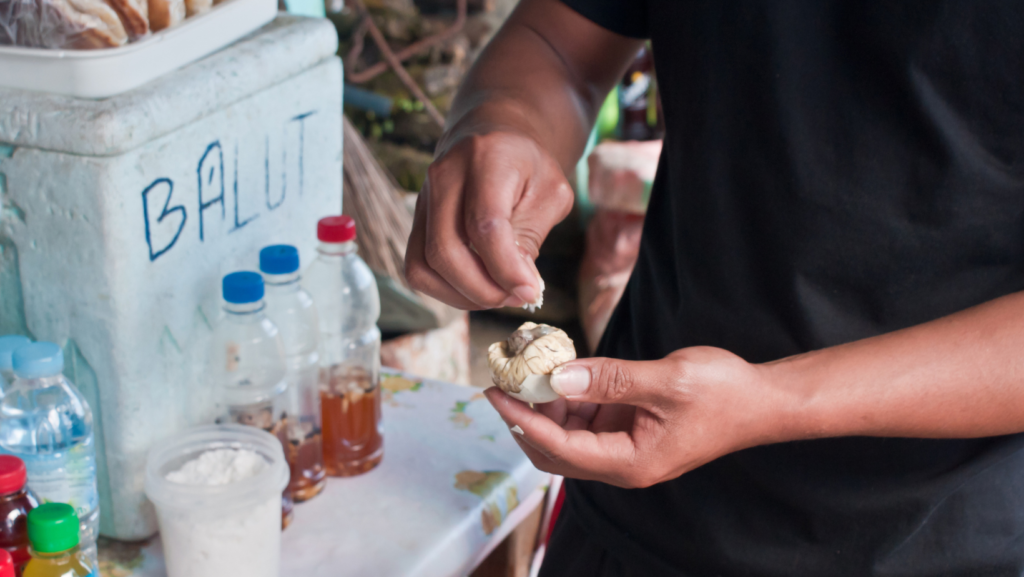Some links on this page are affiliate links. This means we may earn a commission at no additional cost to you if you click through and make a purchase, you can check our Affiliate Disclosure. Thank you for your support!
Have you ever heard of Balut? It’s a unique food that’s a big deal in the Philippines. Let’s discuss what it is and why it’s so special in Filipino culture.
What is Balut?
Balut is a boiled, fertilized duck egg, usually about two to three weeks old. It sounds a bit wild. But it’s a popular snack in the Philippines, especially at night. Picture this: a warm, savory egg with a little bit of a kick, often enjoyed with a pinch of salt, some chili, and a splash of vinegar. It’s a taste adventure!
The Cultural Significance of Balut in the Philippines
It isn’t just a snack but part of Filipino life. Here’s why:
- Street Food Staple: Wander around the streets of Manila, and you’ll find it vendors calling out, “Balut! Balut!” It’s a must-try for the adventurous foodie.
- Symbol of Courage: Trying it for the first time is a rite of passage. It’s like a dare – showing you’re brave enough to taste something so out of the ordinary.
- Celebrations and Gatherings: It often pops up at parties or casual get-togethers. It’s not just food; it’s a conversation starter and a way to bond.
So, It is more than an egg; it’s a slice of Filipino culture. Whether you’re a local or a visitor, giving it a try is a way to experience the Philippines in a whole new way. 🇵🇭🥚

How it is Made
Curious about how it is made? It’s a fascinating process! Let’s break down the steps and also look at how different places in the Philippines put their own spin on it.
The Process of Making Balut
Making it is a mix of science and tradition. Here’s how it’s done:
- Selecting the Eggs: Farmers choose the best duck eggs for Balut. These eggs are just about 9 to 12 days old.
- Incubation: The eggs are kept warm, usually in baskets or incubators, for about 14 to 21 days. The warmth helps the embryo inside the egg develop.
- Candling: Around day 14, farmers hold the eggs up to a light. This step, called “candling,” helps them see if the embryo is growing right.
- Boiling: After the incubation, it’s boiling time! The eggs are cooked until the embryo and the yolk are firm.
- Cooling and Selling: Once boiled, It is cooled and then ready to be sold. You’ll find them on the streets, usually kept warm in baskets or buckets.
Variations in Balut Preparation Across the Philippines
Even though it is a common Filipino food, different regions have their own ways of enjoying it. Here are a few:
- Manila-Style: In the capital, people like it with a bit of salt, vinegar, or a chili-garlic mix. Simple but delicious!
- Pateros: This place is famous for it. Here, they often eat it with a side of spicy vinegar or beer.
- Cebu and Davao: In these areas, It is sometimes served with a special sauce or eaten with rice.
From region to region, it isn’t just about the taste; it’s about the experience. Each place adds its own touch, making it a truly Filipino treat! 🐣🍳🇵🇭
Nutritional Value and Health Benefits
Let’s talk about what’s inside Balut that makes it more than just a tasty snack. Plus, we’ll clear up some myths about its health impacts.
Nutritional Components
Balut is packed with nutrients. Here’s a rundown of what you get in each bite:
- Protein: Essential for muscle building and repair.
- Calcium: Great for bone health.
- Iron: Helps with blood health and energy levels.
- Vitamin C: Boosts the immune system.
- Vitamin B12: Important for brain health and maintaining energy levels.
So, eating it gives you a nice mix of vitamins and minerals that are great for your body.
Debunking Myths About It and Health
Now, let’s tackle some common myths about Balut:
- Myth: It’s Unhealthy Because of Cholesterol: Yes, Balut has cholesterol, but it’s not all bad. Eating it in moderation is key.
- Myth: It’s Unsafe to Eat: Not true! As long as it’s cooked properly, It is safe to eat. Just make sure you get it from a reputable vendor.
- Myth:It Has a Lot of Calories: Actually, it doesn’t have that many calories compared to other snacks. It’s healthy and filling.
Remember, like with any food, enjoying it is all about balance. Knowing what’s in it and debunking these myths helps you appreciate this Filipino delicacy even more. 🥚🍽️👍
How to Eat and Enjoy Balut
I was wondering How do I dive into a Balut experience? Here’s the lowdown on traditional and modern ways to enjoy this Filipino favorite.
Traditional Ways to Consume It
Eating it the classic way is an experience in itself. Here’s how:
- Crack the Shell: Gently tap the rounded end of the it to crack it open.
- Peel a Small Hole: Peel back a bit of the shell and membrane.
- Sip the Broth: There’s a savory broth inside. Tip it up and sip it – it’s delicious!
- Season as You Like: Sprinkle a little salt, or add a dash of vinegar or a pinch of chili.
- Peel and Eat: Now, peel the rest and enjoy the egg. It’s a mix of creamy yolk and a tender, developed embryo.
Modern Twists on Eating It
Nowadays, it isn’t just a street food; it’s making its way into gourmet dishes too. Check out these modern takes:
- Balut Salads: Chopped Balut served over greens with a tangy dressing.
- Balut Tacos: Yep, you read that right! Balut in a taco with some spicy salsa.
- Balut Pizza: Thinly sliced Balut on top of your pizza for a Filipino twist.
Whether you’re a Balut newbie or a seasoned pro, these traditional and modern ways of eating it offer a tasty journey into Filipino culinary culture. So, grab a spoon (or a taco shell!) and dig in! 🍳🌮🥗
Balut in Filipino Cuisine and Beyond
It isn’t just a standalone snack; it’s also a versatile ingredient in Filipino cooking and is even making waves in global cuisine!
ALSO READ: Elevate Your Dinner: Thick-Cut Pork Chops with Roasted Grapes & Fennel
Balut in Filipino Dishes
In the Philippines, chefs and home cooks get creative with it. Here are some ways they incorporate it into dishes:
- Balut Adobo: Imagine your regular chicken adobo but with Balut instead. It’s a rich and flavorful twist!
- Balut Sisig: This dish usually features chopped pork, but with Balut, it gets an extra layer of texture and flavor.
- Balut Soup: A comforting broth with Balut adding depth and heartiness.
These recipes show how it can be more than just a snack – it’s a culinary star in its own right.
Balut’s Influence on Global Cuisine
It is also stepping onto the global food stage. Chefs around the world are experimenting with this Filipino delicacy:
- Balut in the USA: Some adventurous chefs in the U.S. serve it on their tasting menus, often paired with sophisticated sauces or as part of fusion dishes.
- European Fusion: In Europe, you might find it in high-end Asian fusion restaurants, adding an exotic touch to familiar dishes.
- Street Food Festivals: Across different countries, it pops up in street food festivals, showcasing the versatility and appeal of Filipino cuisine.
It is crossing borders and breaking culinary boundaries. Whether in traditional Filipino meals or as part of a fusion experiment, it’s a food that’s both comforting and daring. So, next time you see it on a menu, whether in Manila or Milan, give it a try! 🌍🍳👩🍳
ALSO READ: Discovering the Delights of Filipino Adobo: A Culinary Journey
Frequently Asked Questions
Have you got questions about it? Let’s clear up some common queries and misconceptions about this Filipino delicacy.
Common Questions and Misconceptions
Is Balut Cruel?
Some people worry about the ethics of eating it. It’s important to remember that food choices can be very personal and cultural. It is a traditional food in the Philippines and is consumed with respect to its cultural significance.
Can You Get Sick from Eating Balut?
As long as it’s cooked properly and fresh, it is safe to eat. Just like any egg or meat product, make sure you buy it from a reputable source.
Does Balut Taste Like a Regular Egg?
Not exactly. It has a richer, more savory flavor than a regular boiled egg. The texture is different too, with a combination of creamy yolk and a firmer, developed embryo.
Tips for First-Time Eaters
Trying it for the first time? Here’s how to make it a good experience:
- Keep an Open Mind: Remember, it is a beloved snack in the Philippines. Approaching it with an open mind can enhance your tasting experience.
- Use Condiments: A bit of salt, vinegar, or chili can add to the flavor. Feel free to adjust according to your taste.
- Start with the Broth: Sipping the broth first can ease you into the flavor profile of Balut.
- Look for Freshness: Freshness is key. Make sure you’re getting your Balut from a trusted vendor.
- Eat with Friends: Everything’s better when shared. Try it with friends for a fun and memorable experience.
Remember, eating it is not just about trying a new food; it’s about exploring a different culture. Enjoy the journey! 🥚🌏👍
ALSO READ: Exploring Filipino Flavors: Bicol Express – A Spicy and Creamy Pork Dish
Final Thoughts
Let’s wrap up our journey into the world of Balut, a true gem in Filipino cuisine.
Embracing the Unique Flavor
It is more than just a food; it’s a cultural experience. Tasting it opens a window into the rich and diverse culinary traditions of the Philippines. It’s a reminder that food is a universal language, connecting us across different cultures and backgrounds.
Trying Balut teaches us the value of culinary adventure and the joy of discovering new flavors. It’s about stepping out of our comfort zones and embracing the unfamiliar. Whether you fall in love with it or decide it’s a one-time experience, the act of trying something as unique as Balut enriches your understanding of the world’s diverse food culture.
So, next time you come across Balut or any other new food, give it a go! You never know; you might find your new favorite dish. Here’s to culinary exploration and the delicious surprises it brings!
ALSO READ: Asian Side Dishes – Impress Every Guest with 25+ Feast-Worthy Asian Side Dishes



